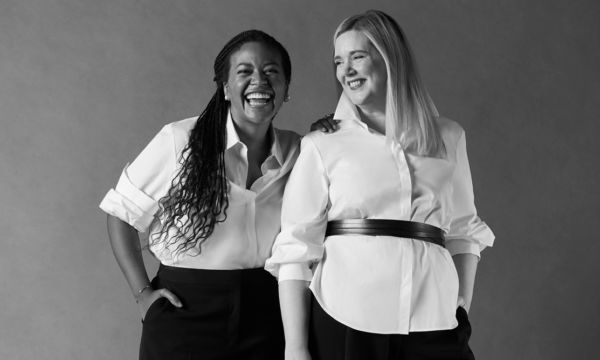9 Improv Principles that Will Help You Manage Conflict at Work
July 05, 2019 | Filed in: Your Career
For many of us, conflict is uncomfortable, especially at work. Yet occasional conflict is inevitable and often healthy, when managed well. So how do we face it productively—and emerge with our relationships and integrity intact?
We called on Shannan Scarselletta, founder of ImproVision and an expert on improvisation, to ask how she helps professionals employ improv techniques in managing real-world conflict. “Deep and curious listening is at the heart of conflict resolution,” says Shannan. “Conflict is a high-stakes, highly emotional situation—just like being on stage. In those moments, we tend to want to seize control, but it’s so much more effective—both in improv and in real life—if you shift into a state of deep listening, non-judgment, curiosity, empathy, and vulnerability. When you are able to operate in this place of ambiguity, you can actually turn a conflict into a win-win.” Here’s how.

Photo courtesy of Shannan Scarselletta.
1. Set the stage, literally.
“During a tense conversation, the environment you’re in can create a feeling of intimacy or barriers. Offices are full of these long rectangular tables, and people often sit across from each other as if they’re facing off. It literally puts you on opposing sides. If you have the opportunity, try to choose a space where people feel they’re on the same team. Sit around the corner of the table or even on the same side, where you can face the other person with your whole body. It sends a message of, ‘I’m with you. I’m listening.’”
2. Come prepared, but stay curious.
“If you’re heading into a negotiation, know what you want and be prepared to communicate it, but stay present. If you’re confronted with something you weren’t expecting, it’s easy to go ‘Poof!’ and disappear into your own head. Fight your way out of that by paying attention to what the other person is saying. Ask questions. Stay curious.”
3. Show your belly.
“When you’re in a conflict situation, it can be hard to focus and maintain open body language. My quick and dirty rule is: show your belly. Not like, lift up your shirt. But sit or stand in a way where your belly is facing whomever you’re talking to. Doing that immediately shifts you into an open, confident stance—you sit up straight, square your shoulders, uncross your arms, open yourself up. It happens naturally, but all you have to remember is ‘show your belly.’”
4. Mirror strategically.
“In improv, mirroring is a rapport-building technique. It communicates to the other person that you are alike in either mindset or behavior. High-EQ people mirror naturally to make others feel at ease. It’s not about using the same gestures, but rather, about trying to match their energy and tone. If they’re quiet, don’t come in shouting. If they’re high-energy, you can throw energy back at them. The goal is to show that you’re in the same boat, that you’re communicating in a way they can relate to.”
5. Honor the other person’s priorities.
“Don’t focus solely on your own agenda. Figure out what the other person wants and values. What does the conflict look like from their side? Then speak to what they want and need, instead of just talking about your wants and needs. Maybe you and your colleague have been conflicting over workload. You can make a powerful move by saying, ‘I know you want this project off your plate. I can take it on, but here’s what I need in return.’ Showing empathy for their needs give you even more power.”
6. Have a “Yes, and…” mentality.
“In improv, this is a principle that means we build off each other’s ideas in a supportive, spontaneous way. It means: ‘I will listen to you; I will acknowledge you; I will embrace the idea you’re throwing at me; and I will contribute to it.’ That tool is what keeps you moving forward creatively when new information is emerging. It replaces friction and argument with momentum and collaboration. It creates problem-solving and empathy where there used to be conflict.”
7. Cede the stage.
“When we’re stuck in improv, we can take the pressure off ourselves by ceding the stage to others. If I say to someone, “You seem frustrated,” then it’s on them to take the scene from there and explain why they’re frustrated. At work, if someone confronts you with something you’re not expecting, redirect the conversation back to the other person. Ask them a nonjudgmental question like, ‘Can you clarify what you mean by that?’ or ‘Why do you think you’re struggling with this?’ Sometimes just giving them space to make a point or vent will help you regain some control when you feel put-on-the-spot.”
8. Employ the power of silence.
“Silence can be uncomfortable, but experienced improvisers know how to deploy it to great effect. On stage, there’s a real gravity to staying quiet. In real life, silence can also be useful. If a conflict starts to spiral, or if you’re asked something you weren’t prepared for, slow it down. Say, ‘Look, I really want to consider what you just said to me. Can you give me a second to think about this before I respond?’ Don’t be afraid to take that time.”
9. Confirm—don’t just assume—you’ve reached a resolution.
“In improv, it’s normal to walk offstage and think, ‘Oh man, I wish I’d said X.’ But too bad. If you didn’t say it, it didn’t happen. When you’re resolving a conflict, it’s always worth it to confirm that everything has been addressed. Close out the conversation by saying, ‘Do you feel like we’re in a good place? Have we solved the issue?” It’s verbal icing-on-the-cake, but it’s important to confirm that you’ve actually reached a solution that everyone feels good about.”
Think your team or company would benefit from doing one of Shannan’s workshops? Read more about them here. Working with her is always a good time. At one particular M.M.LaFleur offsite, she had all the introverts stand up and pretend we were on the moon (thank you for that, Shannan).








